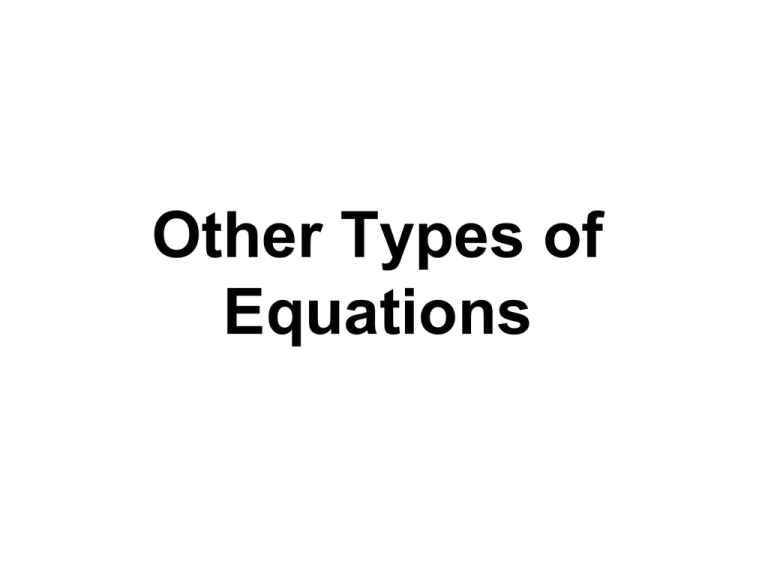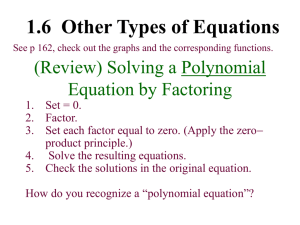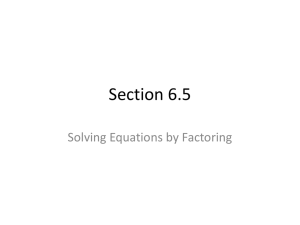Power Point for 1.6 Notes
advertisement

Other Types of Equations Solving a Polynomial Equation by Factoring 1. Move all terms to one side and obtain zero on the other side. 2. Factor. 3. Apply the zero-product principle, setting each factor equal to zero. 4. Solve the equations in step 3. 5. Check the solutions in the original equation. Text Example • Solve by factoring: 3x4 = 27x2. Step 1 Move all terms to one side and obtain zero on the other side. Subtract 27x2 from both sides 3x4 - x2 = 27x2 - 27x2 3x4 - 27x2 = 0 Step 2 Factor. 3x4 - 27x2 = 0 3x2(x2 - 9)= 0 Solution cont. • Solve by factoring: 3x4 = 27x2. Steps 3 and 4 Set each factor equal to zero and solve each resulting equation. 3x2 = 0 or x2 - 9 = 0 x2 = 0 x2 = 9 x = 0 x = 9 x=0 x = 3 Steps 5 check your solution Example Solve: Answer: x -3 7 = 9 x-3 = 2 x-3 = 4 x=7 Radical Equations A radical equation is an equation in which the variable occurs in a square root, cube root or higher root. Example Solve: 3 x x - 5 = 8 Solution: Answer: • Isolate the radical by moving the other terms to the one side x - 5 = 25 - 10 x x 2 • Square both sides to remove the radical 0 = x 2 - 11x 30 • Move all terms to one side • Factor • CHECK EACH “ANSWER”!!!! Only one works!!!! x -5 = 5- x 0 = ( x - 5)( x - 6) x = 5,6 x=5 Solving Radical Equations of the Form xm/n= k • Assume that m and n are positive integers, m/n is in lowest terms, and k is a real number. 1. Isolate the expression with the rational exponent. 2. Raise both sides of the equation to the n/m power. Solving Radical Equations of the Form xm/n= k cont. If m is even: If m is odd: xm/n = k xm/n = k (xm/n) n/m = ±k (xm/n)n/m = kn/m x = ±kn/m x = kn/m It is incorrect to insert the ± when the numerator of the exponent is odd. An odd index has only one root. 3. Check all proposed solutions in the original equation to find out if they are actual solutions or extraneous solutions. Text Example Solve: x2/3 - 3/4 = -1/2. Isolate x2/3 by adding 3/4 to both sides of the equation: x2/3 = 1/4. Raise both sides to the 3/2 power: (x2/3)3/2 = ±(1/4)3/2. x = ±1/8. Equations That Are Quadratic in Form Some equations that are not quadratic can be written as quadratic equations using an appropriate substitution. Here are some examples. Given Equation Substitution New Equation x4 – 8x2 – 9 = 0 or (x2)2 – 8x2 – 9 = 0 t = x2 t2 – 8t – 9 = 0 5x2/3 + 11x1/3 + 2 = 0 or 5(x1/3)2 + 11x1/3 + 2 = 0 t = x1/3 5t2 + 11t + 2 = 0 Rewriting an Absolute Value Equation without Absolute Value Bars • If c is a positive real number and X represents any algebraic expression, then |X| = c is equivalent to X = c or X = -c. Example Solve: 3x - 1 = 4 Answer: 3x-1=4 and 3x-1=-4 solve, 3x=5 3x=-3 x=5/3 x=-1 Other Types of Equations



